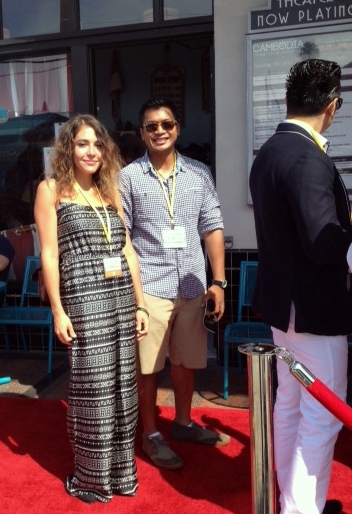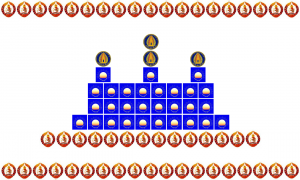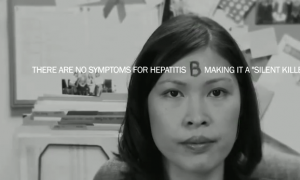
Khmerican staff member David Doeum on the red carpet at Long Beach’s Cambodia Town Film Festival.
By David Doeum
Long Beach, Calif. – There was an unexplainable feeling waking up knowing that the weekend ahead would not only have a positive impact on me, but also an entire community. Saturday, September 14th, 2013, the first day of the Cambodia Town Film Festival (CTFF), became the epicenter of a rich, vibrant culture that has lain dormant for over 30 years yet perseveres with resilience, commitment, and welcoming arms, hands pressed together to greet its audience: chum reap sur. The two-day event created dialogue through various films that intended to push the mind to discover or even rediscover a sense of identity within the Khmer culture.
As I made my way down Junipero Avenue to 4th Street’s “Retro Row,” the feeling became more recognizable as the warmth of creativity—as it exists in a cup of coffee that one can find at the corner Portfolio Coffeehouse, where many creative types go for caffeine-fueled inspiration, in fact.
Along with that local venue, there’s a thrift shop where you can find your next ugly sweater for that Christmas party, a vintage furniture spot for a rare teak Dutch desk, a roller skate shop for the likes of the Long Beach Derby Gals, and a couple barber shops for the next “high and tight” cut. The neighborhood embraces embraces these unique, unapologetic personalities. The storefronts lead up to Cherry Street and the city’s oldest single-screen venue still in operation, the Art Theatre, where the festival took place throughout that weekend, the first screening being a documentary titled “A River Changes Course.”
And that weekend, it truly felt like a transformation was underway.
One might have expected the mood to be chaotic, the festival being the first of its kind, but there was a sense of restrained enthusiasm interwoven among the organizers, attendees, and surrounding businesses. Although the buzz and jitters were definitely present, the occasion was different because when there is a mutual understanding of how special something is, nerves become an afterthought to what really matters.
CTFF co-directors praCh ly and Caylee So, along with their committee members and volunteers, did a tremendous job ensuring the event would kick-off successfully. They prepared meticulously by reaching out to sponsors such as the Aquarium of the Pacific and the Port of Long Beach, by traveling to national landmarks like the White House to promote the event, and by aligning resources around guerilla marketing tactics. As one of the most bike-friendly cities in the country, why not gather krama scarf-wearing riders together to pass out flyers around town?
I arrived to a line going around the corner of the intersection, then met up with the producers of the upcoming documentary “Year 33,” Kathryn Lejeune and Janna Watkins of Sueño Documentary Films. Their work captures not only an art revival in Cambodia but also reinforces the act of collaborating to bring about change with the SELPAK initiative, campaigns tied to better support for the arts. After a slight bottleneck on the red carpet, we showed off some pearly whites for the camera and searched for seats. The Khmer Arts Academy began the festival with apsara dancers performing the wishing dance ceremony, giving a benediction before the screenings themselves.
“A River Changes Course,” the winner of Sundance’s World Cinema Grand Jury Prize: Documentary, invited the audience to the backbone of Cambodia in the form of the fishnet-casting and rice-farming lives of residents who are constantly struggling to hold onto traditional ways of living against the pressures of globalization. Director Kalyanee Mam did a wonderful job highlighting three very distinct lifestyles that share the same heavy burden that a globalized market creates for a country still recovering.
A young boy named Sari Math and his family rely on the scarcity of fish catches; he is later obligated to leave the river community to work for a Chinese company that has invested in a large field of crops. There is Khieu Mok, who is instrumental in helping with her family’s rice harvest, but who like many young women find themselves with insufficient money to pay off growing debt, decides to work in the garment industry. Lastly, Sav Samourn works tirelessly to raise a family in rural jungles and is one of the few who decide not to sell the land, with the distinct possibility of a disappearing forest on the horizon. The film’s subtleties around these stories created questions that reflect the growing demands and challenges of world economic development, with little time for those affected to adjust, cope, or find solutions to protect their way of living.
The next film screened, “Still I Strive,” was written and directed by Adam Pfleghaar and took an incredibly unique and very touching approach in telling the story of one orphanage in Phnom Penh. Young children with varying degrees of a hardship in their upbringing are guided by Peng Phan, who steps in as a surrogate mother and uses traditional performing arts to help them work through their internal struggles. These children routinely perform at the local night market and now have a very ambitious objective: to showcase their skills before the Royal Princess Bopha Devi.
There is an imaginative narrative threaded into the documentary, revealing other elements and layers not only about the protagonists within the group, but also a reflective poetic message for the Cambodian people, which can only leave one humbled. It is a message about sticking together, letting go of our dark past, and becoming more self-aware to achieve our dreams. And the lead boy, Rothana, sang these songs and melodies with confident pride, setting the tone throughout their journey. Some light-hearted moments helped ease the very emotional accounts of what these kids have endured, but it was clear that their passion made them the star performers that they are.
Later in the evening, I attended the after party to congratulate those involved on a great premiere. I was also eager to try local brews from the Stone Temple Beer Company, a startup that showcased two styles: a dark Kampot pepper IPA and a golden “Noble Truths” ale. We toasted and proceeded to let the festivities continue.
A surprise performance from Chhom Nimol of Dengue Fever got the traditional Cambodian line dancing going, followed by Indradevi, who also blessed the dance floor with electronic drum and bass music. After we let the vibes knee-jerk our bodies until we shut the place down, I walked back to my car clutching a couple bottles of brew I had purchased. I couldn’t have been happier.
I made a point of being on time the following morning for the screening of “Golden Slumbers” to understand the history of Cambodian cinema before the Khmer Rouge era. Prior to the regime, filmmakers with limited resources and tools created their own techniques, mastered lighting, and made hundreds of films. Although the war halted the production and preservation of many, the nostalgia of that era still holds influence.
The remainder of the festival consisted of a series of shorts that included “Neang Neak,” an experimental film from Studio Revolt that was the one of the most artistic, creative, and colorful of those screened. “My name is Asiroh” had angelic stop-motion storytelling about the origin of the director’s name. Festival co-director Caylee So’s film “Paulina” presented a story about gambling addiction within a Cambodian family. I also enjoyed “Prom Date,” which was impressively completed in two months before the submission deadline.
The CTFF selection committee decided on a number of films that encouraged more understanding and insight on the Cambodian community as a whole. As I mentioned earlier, these stories spoke to our persevering and resilient spirit. It’s what we’ve emulated from our elders, whose incense continues to burn. Through partnerships and collaborative efforts, many aspects of each story start to embody new meaning for both its creators and their audience. The process of making a film to be screened becomes therapeutic. That’s why they’re made—shared experience to discuss our commonalities.
This was not just another film festival, because it served as a support group for finding answers to questions we haven’t yet asked of ourselves. In doing so, this event will hopefully continue to shape a more refined identity for Khmer culture as it welcomes the world to join in on the conversation. Until then, chum reap leah.












